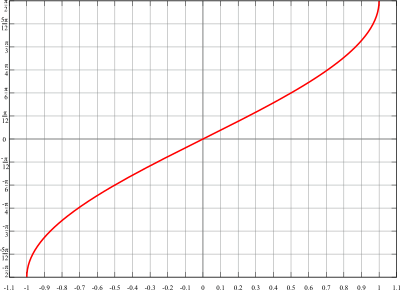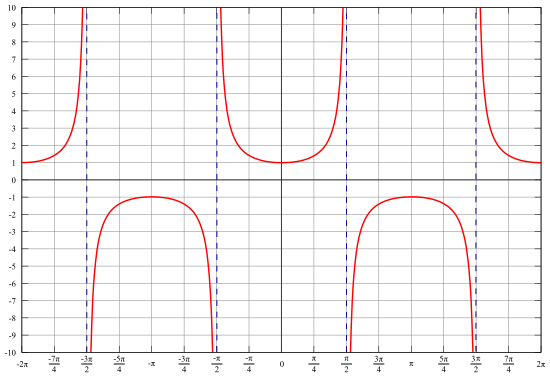The Inverse Trigonometric Functions
You can find the angle that corresponds to a value using the inverse trigonometric functions usually listed as on your calculator. The inverse trigonometric functions have a limited range because the trigonometric functions have a limited output. The function arcsine has a range of -π/2 rad = y = π/2 rad, arccosine has a range of 0 rad = y = π rad, and arctangent has a range of -π/2 rad < y < π/2 rad. Below are the graphs of the inverse trigonometric functions. Note, the arctangent function has asymptotes at y = -π/2 rad and y = π/2 rad.
| Function | Inverse Function | Written | Equivalent to | Graph |
|---|---|---|---|---|
| Cosine |  | |||
| Sine |  | |||
| Tangent |  | |||
Example
What cosine value produces an output of .9396?
arccosine(.9396) = .3490 rad.
What Sine value corresponds to the output .9510 and is between π and π/2.
arcsine(.9510) = 1.2566
π rad - 1.2566 rad = 1.8850 rad
The Reciprocal Trigonometric Function
A reciprocal of a function is 1/function, so when you multiply the reciprocal by the function your resultant is one. Since you can never have a zero in the denominator, the reciprocal function will approach asymptotes at the point when the function is zero. These are the blue lines below. Another relationship to remember is the smaller the value of the original function the larger the reciprocal function value will be.
| Function | Written | Equivalent to | Inverse | Graph |
|---|---|---|---|---|
| secant |  | |||
| Cosecant |  | |||
| Cotangent |  | |||
The Trigonometric Identities
There are a number of useful identities for us to solve the problems of trigonometry. These useful identities are derived from some simple identities by different calculation. The followings are the identities required in the C3 syllabus.
Pythagoras Identities
In Core three two additional Pythagorean identities are introduced for the three reciprocal functions. This allows us to solve a problem involving the secant, cosecant, or cotangent functions. They are both derivation from the Pythagoras identity in Core 2 if we divide it by or . The two identities are:
Example for Secant Identity
Solve for x in radians:
Replace using the Pythagoras Identity.
Expand and bring all variables to one side
Factor
Solve for sec(x).
Solve for x
Example for Cosecant Identity
Solve for cotangent of x
Replace Cosecant with the identity.
Expand
Factor
Solve for cot(x)
Addition and Subtraction of Compound Angles
Compound Angle formulas are very useful in a variety of circumstances, they can deduce the exact values of the angles 15° and 75° and they can also be used to find values of compound angles when one angle is unknown. These formula are very important later on in A-level Mathematics. The formulae that you need to know are:
Note: The sign means that if you add the angles (A+B) then you subtract in the identity and vice versa. It is present in the cosine identity and the denominator of the tangent identity.
Example One: The value of cos(15°)
Find the exact value of cos(15°):
We can break up cos(15°) into a compound angle:
cos(15°) = cos(45°-30°)
Now using the identity:
Since we learned these values in core 2 we get
Example Two: The value of sin(A+B)
Find the value of sin(A+B) when and
Imagine you have two triangles and use Pythagoras formula to find the remaining side.
We can now write out the other two values.
Now we can solve using the identity
Double-Angle Formulae
The double angle formulae are obtained from the compound angle formulae when b = a. The double angle formulae for cosine is a good reminder that when you have cos(a+b) you subtract in the identity or else you would get that cos(2a) = 1, also there are three identities that you need to know.
Example
What is the value of cos(2x) when sin(x) = .92? Find the angle that corresponds to 2x express your answer in radians.
Using the identity for cosine we get:
Using arcosine we get that:
Linear Combinations of Trigonometric Functions
Linear combination are very important in analysing waves, using radians we can determine that r is the amplitude of the wave and α is the phase of the wave. If you are ever asked for α give the answer in the approximate numerical answer. The formulae for linear combination of trigonometric functions are:
where
where
Example
Express the function in terms of cos(x). Solve for x in the range 0° < x <360°, when
. Extract R from the equation:
Solve for α
Express the function in terms of cos(x)
Now we need to solve for x when it is equal to 3:
In the range 0° < x <360° we get
This is part of the C3 (Core Mathematics 3) module of the A-level Mathematics text.